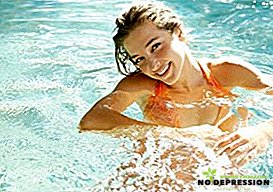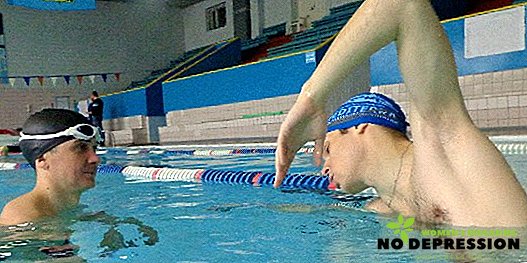Before you learn the different swimming techniques and explore the depth, you should learn how to float on your own. Many have seen in bodies of water children with swimming circles, vests, mattresses and other devices that hold the surface of the water.

A person who has decided to learn how to swim independently, all this can be useful only for understanding the very mechanism of holding on the water. The air bubble in one form or another helps the body not to sink.
On this understanding, many exercises are based to keep the body in water, which will be described below. Let's learn how to learn to float.
Tips for those who want to learn how to float
For a start, I would like to present some important tips for those who are just learning to float:
- start training should be in stagnant water at shallow depth, the ideal place for this is the pool;

- before entering the water, it is necessary to warm up the muscles and joints in order not to feel the constraint of movement, which can be aggravated by cold water;
- it is best to start training in a pool or reservoir with not too cold water (this will calm and relieve muscle clamps);
- during training, there should be an instructor nearby, or at least a person who can swim quite well;
- Start learning in a calm, concentrated state.
Overcoming the fear of water
Fear of water exists in many people, especially in those who cannot swim. Uncharted depth scares someone, most are afraid of drowning or swallowing water. But one thing remains the same: to learn to swim you need to overcome fear.
- fear arises from self-doubt and helplessness, since it creates the feeling that a person who cannot swim is powerless before the water element;
- in order to understand that this is not the case, it is necessary to evaluate the pushing and holding property of water; for this, it is enough to enter the water along the chest, inhale more air, sit down, clasping your knees with your hands, and dive into the water with your head; water will push the person, leaving in this position;
- Having calmed down and having understood that water itself holds the human body, one can start training at a shallow depth with the support of an experienced swimmer or instructor.

Exercises for holding on water for children and adults
You can learn to swim at any age. Children, adults, the elderly - everyone can comprehend this simple science, if they really want.
For this occupation there are no restrictions on weight, build, sex, social status - water keeps everyone and everyone. The main thing in this matter, as in many others, is overcoming and perseverance.
Tips for teaching children
 Learning many things is given to children much better than adults. Swimming is no exception. At the age of 5-6 years old, you can safely teach your child to float independently, and after, to swim.
Learning many things is given to children much better than adults. Swimming is no exception. At the age of 5-6 years old, you can safely teach your child to float independently, and after, to swim.
Unlike adult education, children should not be left unattended at such a crucial moment. It is best to study in the pool at a shallow depth, since there is no current there, and there are also elements of additional insurance, for example, bumpers and ladders.
First of all, have the child stretch out on your arms. The insurance will help the child to reduce the fear of water and to feel its support.
After the child has learned to keep himself on the water in the hands of an adult, you can try to hold yourself with the support. Holding on to the side you need to lie on your stomach, face down, having preliminarily taken in air.
In this position, the child needs to relax and allow the feet to surface. So, changing the position, children can learn to control their bodies.
When the child is sure that he is ready to lie on the water surface without support, you can give him that opportunity under the supervision of an adult.
To do this, you need to be at a shallow depth, where the child can reach the bottom with his feet.
Tips for adult education
In adulthood, training is more difficult, but, with patience, you can learn to swim, even in retirement. This will help some of the exercises described below. So, how to learn to float on an adult?
Exercise "Float"
Uh This exercise makes it clear that water itself holds the person, and get rid of the fear of depth. Doing this exercise is necessary in the pool in standing water.
This exercise makes it clear that water itself holds the person, and get rid of the fear of depth. Doing this exercise is necessary in the pool in standing water.
- plunging along the chest you need to squat;
- from a sitting position, pull your knees up to your chin and clasp them with your hands;
- relax and roll face down;
- Thus, the water will push the person back up, and leave in such a position as a float; at the end of the exercise, you need to calmly turn around and stand up.
Exercise "Starfish"
 Exercise is great for both children and adults who have already learned to partially float or hold a grouped body (see the exercise "float"). It is also made in stagnant water.
Exercise is great for both children and adults who have already learned to partially float or hold a grouped body (see the exercise "float"). It is also made in stagnant water.
- go into the water to a sufficient depth;
- inhaling full breasts, you need to immerse your face in water;
- stretching your arms forward and setting them apart, you need to slowly lift your legs from the bottom of the pool and also arrange them to the sides;
- having relaxed, keep in this position, after which you can safely stand on your feet.
Exercise "Sliding on the surface of the water"
 This exercise is suitable for those who already learn to keep the body well on the surface of the water without jigs and supports.
This exercise is suitable for those who already learn to keep the body well on the surface of the water without jigs and supports.
- go into the water at a sufficient depth;
- gently sink face down into the water; the legs must remain at the bottom;
- after the body is immersed in water, you need to push off your feet from the bottom, trying to remain at the same time in a horizontal position;
- when you learn to move on the surface of the water in this position, you can begin to connect the legs, helping them advance in the water.
Exercise "Sliding on the back"
 This exercise is similar to the previous one, only as a support for the push here is a side, and the movement is done lying on the back. When performing this exercise, you need to check in advance that the path behind you is free, as the exercise gives the swimming a considerable acceleration.
This exercise is similar to the previous one, only as a support for the push here is a side, and the movement is done lying on the back. When performing this exercise, you need to check in advance that the path behind you is free, as the exercise gives the swimming a considerable acceleration.
- having turned the face to the side, fix the hands on the handrail of the side of the pool with the lower grip;
- holding both hands on the handrail, gently pull up the bent legs to the chest, placing the feet on the underwater part of the side;
- push off from the side, at the same time releasing the hands and pressing them to the body;
- after achieving good results, you can try to use the legs.
The transition from water retention to the first swimming stroke
After you have already learned how to keep well in the water and find out that you are able to move, without compromising balance, you can proceed directly to swimming.
It is best to begin rowing from the slip exercises. As a rule, the first thing that is learned in mastering swimming is the “dog-like” style.
- pushing from the side or bottom, start to slide on the water;
- realizing that you are well kept on the surface, lift your head out of the water high enough not to swallow the spray;
- connect hands, alternately making short movements of them out of the water and back to the body, raking the water as it were for themselves;
- perform the exercise until it starts; so you need to stay on the water and move forward a little.
Once you have learned to swim like a dog, you can start exploring other swimming styles.

Hold in depth upright
And how to learn to float on the water vertically? Having learned to stay on the water in a horizontal position, it is much easier to vertically hold the body in the water.
To do this, gradually entering the water, begin slow and smooth movements of the legs and arms. Hands in this position are located in the same plane with water, the purpose of their movement is to create an air bubble around a person, which will hold in water in the desired position.
Legs, moving smoothly alternately, play the role of a “motor” that repels from the bottom.
The arms, when held vertically at depth, can move in different ways, but all movements are made from a person; when returning to the body, the arms move more smoothly. It is important to maintain the smoothness and amplitude of movements in such a position, since uneven jerks and rhythm changes can lead you to the bottom.
Swimming is a useful and enjoyable process that can be learned at any age, there are no restrictions (except for restrictions on certain diseases). Training can take a lot of time and effort, and it can be easy and fun, but anyway, as a result, you will be able to find freedom in water and get a new way of healthy recreation.
And a few more tips that can help learn to swim - in the next video.














